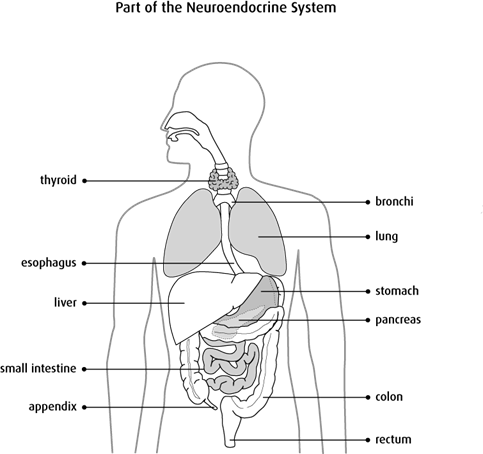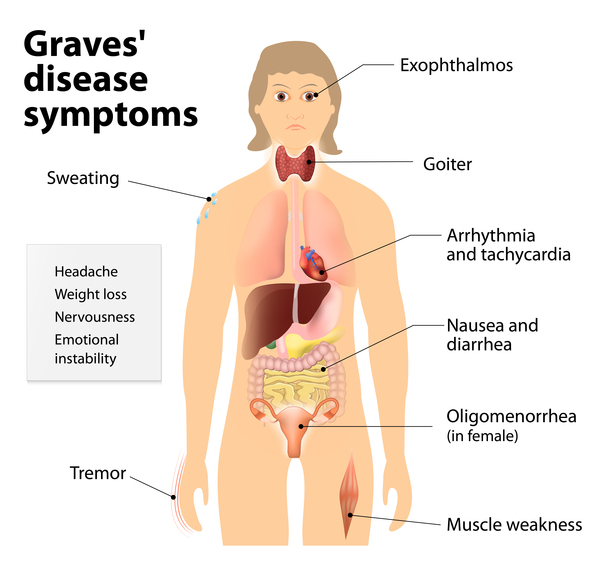In an ideal and healthy organism, all systems and organs work perfectly and harmonically. However, genetics and environment may affect one’s body and cause various diseases. It may happen that a system or an organ fails due to a virus, an unhealthy lifestyle, or poor heredity and knocks the rest of the body off the right rhythm. The purpose of this paper is to explore the symptoms, diagnostic methods, treatment, and possible prognosis of Graves’ disease.
Graves’ disease is an autoimmune condition that is believed to be caused by a combination of environmental and genetic factors. The condition is located in the neuroendocrine system, which is made up of gland cells and nerves (Cancer Research UK). Overall, there are numerous organs that can be included in the neuroendocrine system (Figure 1). According to Barry and McFadden, it can be divided into two: a diffuse system and a glandular system. The former comprises the “cells dispersed throughout the skin, thyroid, lung, thymus, pancreas, gastrointestinal (GI) tract, biliary tree, and the urogenital system,” while the latter consists of “the pituitary, parathyroids, paraganglia, and adrenal medulla” (Barry and McFadden 941).

Further, it is essential to explore the process of the disease in order to understand its symptoms, diagnosis, and treatment methods better. As noticed by researchers, certain causes of Graves’ condition are unknown. What they are certain about is that one’s “immune system makes an antibody called thyroid-stimulating immunoglobulin (TSI)” that acts like a thyroid-stimulating hormone (TSH) and attaches to the thyroid cells (National Institutes of Health). Because of TSI, the thyroid, which is a gland in the shape of a butterfly in the front of one’s neck, creates excess amounts of thyroid hormone, which make the body’s processes speed up (National Institutes of Health). Numerous problems occur because some parts of the body, including the thyroid itself, work harder than they need to.
Since, in most cases, an early diagnosis can guarantee a successful outcome, it is vital to be aware of the most common signs of Graves’ disease. First, as stated by medical professionals, the symptoms of this condition may include the signs of hyperthyroidism, namely, weight loss, shaky hands, trouble tolerating heat, enlarged thyroid gland, irritability, and irregular heartbeat (National Institutes of Health). Second, eye issues may involve bulging, irritated, and puffy eyes, double vision, light sensitivity, and eye pain (Gardner). Finally, there can also be skin problems, with the skin becoming thick, rough, and reddish. Figure 2 highlights some other most common symptoms and shows their locations.

To diagnose Graves’ disease, it is required from a medical worker to administer certain tests. First, blood analysis should indicate the levels of hormones produced by the thyroid: triiodothyronine (free T-3) and thyroxine (free T-4), as well as the levels of TSH (Gardner). If the former is too high and the latter is abnormally low, it is likely that the patient has Graves’ disease. Further, since the thyroid requires iodine to produce hormones, it may be effective to take a radioactive iodine uptake test to determine the levels of iodine.
The two key objectives of any treatment are to relieve discomfort and restore the levels of the thyroid hormones. Therefore, beta-blockers can reduce symptoms but do not affect the disease itself (Gardner). Antithyroid medicines can lead to the lower creation of TSI but have many side effects (National Institutes of Health). Radioiodine therapy can be used to destroy the thyroid gland’s cells (Cleveland Clinic). When the aforementioned methods cannot be selected, the doctor may choose surgery to remove part of the thyroid gland.
Finally, as mentioned above, it is crucial to have an early diagnosis to have better outcomes because, if left unaddressed, Graves’ disease can lead to the patient’s death. According to Cleveland Clinic, the treatment is a life-lasting process. If the treatment is thyroidectomy or radioactive iodine, the person will eventually develop hypothyroidism, and in case they take antithyroid drugs, this process will never end. At the same time, the prognosis is quite positive as it is possible to control the condition.
It is essential to mention some engaging facts about the neuroendocrine system and related diseases. For instance, neuroendocrine tumors (NET) are challenging to be identified, and about ninety percent of NET patients receive wrong diagnoses (Cancer Research UK). Second, it is interesting that “the pituitary gland, the parathyroid glands and the inner layer of the adrenal gland (adrenal medulla) are almost all made up of neuroendocrine cells” (Canadian Cancer Society). This system plays an essential role in one’s body, performing the function of the messenger.
To draw a conclusion, one may say that being diagnosed with Graves’ disease is not a sentence. While it often requires lifelong treatment, when addressed and taken under control, the condition does not worsen the patient life and does not make it extremely uncomfortable. The main purpose is to pay attention to the symptoms and visit a doctor in a timely manner to receive a diagnosis and develop an adequate treatment plan.
Works Cited
Barry, Linda, and David W. McFadden. “Gastrointestinal Carcinoid Tumors.” Shackelford’s Surgery of the Alimentary Tract, edited by Charles J. Yeo, 8th ed., vol. 1, Elsevier, 2019, pp. 939-950.
Canadian Cancer Society. “The Neuroendocrine System.” Canadian Cancer Society. Web.
Cancer Research UK. “What Are Neuroendocrine Tumours (NETs)?” Cancer Research UK. Web.
Cleveland Clinic. “Graves’ Disease.”. Web.
Gardner, Stephanie S. “Graves’ Disease.” WebMD. Web.
MedlinePlus. “Graves’ Disease.”. Web.
National Institutes of Health. “Graves’ Disease.” NIH. 2021. Web.